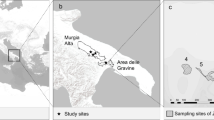Abstract.
Many arthropods produce clusters of eggs, but an unambiguous explanation for the evolution of egg clustering is still lacking. We test several hypotheses for the production of egg clusters by the predatory mite Iphiseius degenerans. This predator feeds on pollen, thrips larvae and nectar in flowers, but oviposits in clusters in tufts of leaf hairs (acarodomatia), where eggs run a lower risk of being killed by thrips, the prey of this predatory mite. The observed clustering is not caused by a shortage of oviposition sites; females preferably oviposit in a domatium containing eggs rather than in an empty domatium. To explain this preference, we first examined the effect of egg clusters on the risk of cannibalism. We found that eggs are invulnerable to cannibalism, whereas larvae emerging from single eggs or from clusters were equally vulnerable. Subsequently, we considered the killing of eggs resulting from counter-attacks by prey, i.e. the western flower thrips. We found no indication that a cluster of eggs protects eggs from predation by thrips. However, when eggs were clustered in a domatium rather than scattered over domatia, the proportion of eggs killed by thrips was lower. Hence, oviposition in clusters has no effect on its own and oviposition in domatia reduces predation risk by thrips, but oviposition in clusters in domatia leads to a synergistic effect on the survival of predator eggs. This synergism probably arises because eggs in clusters within tufts of leaf hairs are more difficult for thrips to reach. These experiments highlight a novel explanation of egg clustering, i.e. adaptation to counter-attacking prey. Moreover, they show that plant domatia protect predator eggs from predation.
Similar content being viewed by others
Author information
Authors and Affiliations
Corresponding author
Additional information
Electronic Publication
Rights and permissions
About this article
Cite this article
Faraji, F., Janssen, A. & Sabelis, M.W. The benefits of clustering eggs: the role of egg predation and larval cannibalism in a predatory mite. Oecologia 131, 20–26 (2002). https://doi.org/10.1007/s00442-001-0846-8
Received:
Accepted:
Published:
Issue Date:
DOI: https://doi.org/10.1007/s00442-001-0846-8




